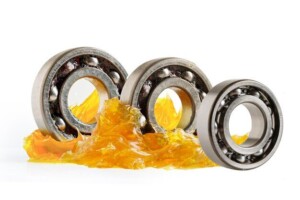Lubrication is absolutely essential for the proper functioning of ball and roller bearings. The right lubricant will reduce friction between the sliding surfaces inside the bearing components and reduce or prevent metal-to-metal contact between the rolling elements and their raceways. Proper lubrication reduces wear and prevents corrosion, ensuring long bearing life. Most NSAR bearings are greased, but follow our instructions when you need to refill.
Lubrication, especially circulating oil, also removes heat from the bearing.
First, most sealed bearings are prefilled with 25%-35% grease from the factory. This is all the grease the bearing needs, as the refill interval is longer than the expected life of the bearing.
There are eight simple steps to regreasing a bearing:
Make sure the motor is running and hot, or the motor is off but still hot. (Under running conditions, the grease viscosity is lower.)
Make sure the grease gun contains the appropriate lubricant for the bearing that needs to be regreased.
Clean the area around the fill and drain fittings to ensure contaminants do not enter the bearing cavity.
Remove the drain fitting and allow excess grease to drain from the bearing.
Do not remove the drain plug during the entire relubrication process.
With the motor running at operating temperature, add the recommended amount of grease, or slowly add until it begins to enter the drain tube.
After removing excess grease, reinstall the drain plug and clean excess grease from the drain area.
After installation, monitor motor noise and vibration to establish a baseline. Check these measurements regularly; any sudden or significant changes should lead to checking bearing lubrication.
(When installing replacement bearings, injecting grease into the bearings should be one of the last operations completed to ensure cleanliness and minimal contamination.)

The most accurate measurements will come directly from your motor manufacturer. If no specifications are available, pump grease slowly and carefully until clean grease flows from the drain port. Do not pump too quickly, or grease may be forced through the bearing seals and into the motor cavity.
While lubricating bearings once a week or month may seem like a practical task, it actually causes more harm to the bearings than good.
Bearings need grease for one reason only – to prevent and reduce friction. If the lubricant is working well, there is no need to continually change or add lubricant.
Friction levels can be monitored, measured and trended so you know exactly when is the best time to lubricate. NSAR has the flexibility to provide the bearing solution you need for your small or niche application.
Copyright © NSAR Bearings. All rights reserved. Privacy Policy